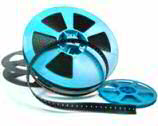 Digital equipment simplifies most aspects of recording, yet high profile studios still work in analog, often recording to magnetic tape. Why stick with the older, more expensive technology (especially with the panic over Quantegy’s decision to stop making tape?)
Digital equipment simplifies most aspects of recording, yet high profile studios still work in analog, often recording to magnetic tape. Why stick with the older, more expensive technology (especially with the panic over Quantegy’s decision to stop making tape?)
Ethan Winer offers some thoughts on the matter in his article Gaining an Edge with Subtle Distortion:
Years ago I did a mix in my DAW and made a cassette copy for a friend. I noticed the cassette sounded better – more “cohesive” for lack of a better word – and I liked the effect. A few times I even copied a cassette back into the computer, used a noise reducer program to remove the hiss, then put the result onto a CD. I knew it was an effect, not higher fidelity or the superiority of analog tape, but I had to admit I liked the effect.
Recording to magnetic tape is inherently lossy. (Spend some time reading about tape bias and AC bias to see just how tricky it is to capture acoustic detail on magnetic tape.) However, Winer discovered that the low-level distortion introduced when recording to tape adds pleasing qualities to a mix.
This surely has something to do with habituation. We’re used to hearing great musicians recorded to tape, so we associate the qualities of tape recordings with great-sounding music. But it’s also somewhat counter-intuitive that digital recordings, which capture far more detailed representations of the sound we hear, should ultimately sound less pleasing.
Charles Dye expands on this in his Hard Disk Life column. From the article on distortion:
With each improvement in the recording process, as the electrical engineers were eliminating distortion that was at first perceived as degrading the audio, recording engineers later realized once the distortion was missing that sometimes it added qualities that actually improved the audio. As it turns out, certain instruments and certain styles of music benefit greatly from different types of distortion. And other instruments and styles benefit from being kept as clean and distortion-free as possible. With today’s technology, the ability to record a clean and transparent signal is not difficult. At times, that is exactly what you want, but at other times you want a sound to be as gritty and crunchy as you can make it, or anywhere in between. We now have the freedom to choose the type of distortion, how much, and when.
Dye mixed Ricky Martin’s La Vida Loca, the first all-digital song to hit number 1. He described his Grammy-winning mixing process in the Hard Disk Life series, and in the article quoted above he spells out his technique for making digital recordings sound more like tape. In a nutshell: Mix with distortion. Simulate the distortion added by analog equipment in your digital recordings.
He uses McDSP plugins for most of his tape and analog channel emulation, but they’re expensive, and available only for Protools. Thankfully for those of us who’d like to try his technique, there’s no shortage of plugins more reasonably priced.
The commercial options include PSP Vintage Warmer (probably the best all-around saturation plugin available) and Voxengo Tapebus (which is PC-only.) If you own Cubase, you may already have Spectral Design’s Magneto tape simulator.
NomadFactory’s Tube/Tape Warmer and the multi-talented Analog Trackbox also add the desired type of distortion to audio.
There are even some free VST plugins for generating analog-style distortion. (Unfortunately, they’re all PC-only.) Digital Fish Phones’ endorphin is really a compressor, but it models analog circuitry that pleasantly saturates the sound. JS Magneto and Jeff Rippe’s Saturator are more straightforward tape simulators.
Finally, don’t overlook the old-school option that Ethan Winer employed: Try dumping your final mix to a separate tape deck, for the ultimate in realistic tape distortion!
Previously on Hometracked: The Big Page of Mix Tutorials, Distortion for Brighter Mixes
For more mixing tips, and tips on home recording in general,
Subscribe to the Hometracked feed, or receive email updates.
Tags: distortion, mixing, professional-engineers, tape

5 comments
Trackback URI Comments feed for this article
Thanks, great article.
would you explained what parameter that used in tape saturator, like a glueing, compressor,
I definitely think a big problem that many all digital home recording studios have is having mixes that are actually “too clean” .. they end up sounding harsh. Subtle analog style distortion seems to make the listening experience more enjoyable. I think it may also make the recordings more… interesting to listen to repeatedly… while the more stale clean recordings may sound fine at first, they lose interest over time.